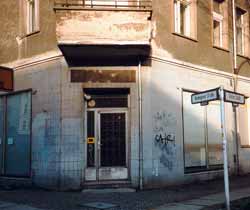
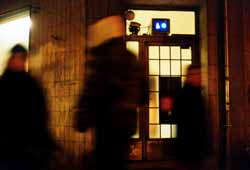
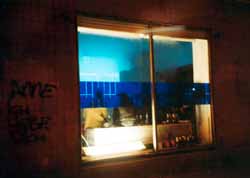
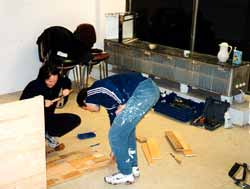

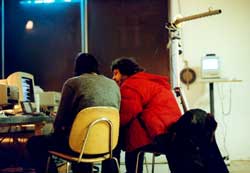
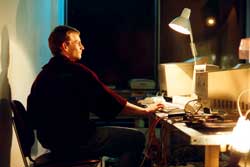
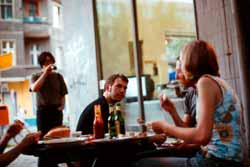

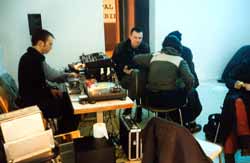

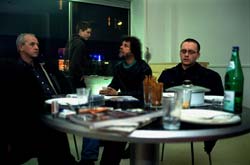
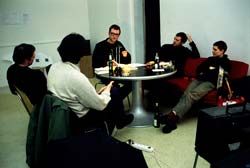
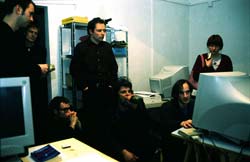
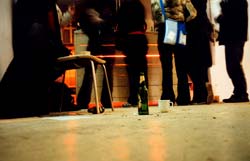

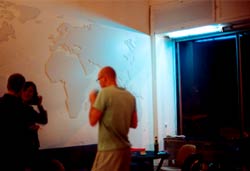

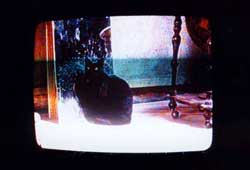
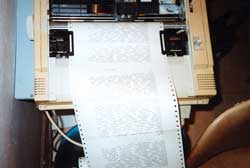
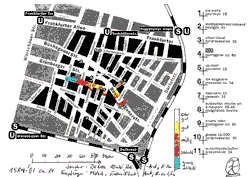

[][][]INFORMATION |
[][][]DATES |
[][][]ARCHIVE |
[][][]PICTURES |
|
Email-Interview "[][][]Boxhagener86/modukit" Sascha Büttner re: Marc Geist, Rena Raedle, Matze Schmidt, Karsten Asshauer translation/editing: Annette Grund Since when does Boxhagener86 exist ? ° We rented the formerly vacant shop at Boxhagener Str.86/Friedrichshain for one year. (jan01-jan02) We were one of the projects supported by the "Quartiersmanagement Friedrichshain/Berlin (1)." In the meantime we got an idea about power structures Friedrichshain and the specific role of the Quartiersmanagement, but this would be a subject on its own. We're part of the ongoing process of restructuring the 'kiez', so we feel a strong connection to the neighbourhood. We are in contact with people who are monitoring the unfolding of gentrification and organizing within community-projects.° ≠ Moreover, the space already 'existed' for a long time as a project permanently under construction. The real space didn't change a thing. The space is a 'Progress'. 'Progress' is the brand name of a cleaner and there was also a space shuttle called 'Progress'. Space shuttles are temporary 'bodies'. They are able to plug in with others, but only when compatibility has been prearranged. In this sense Boxhagener86 is a site under permanent re-modelling and extension.≠ Is there still something like a "Viertel", a distinct social formation ?
°In areas of gentrification the genuine social structure of the Viertel is disintegrating. ≠ Since 2000 some parts of former East-Berlin are marketed as 'chique'. The transference of cultural capital has been central to these marketing techniques.
There are quite a lot of people from Berlin monitoring 'global' phenomenon like gentrification Well, Friedrichshain is periphery, but it's also hip. Boxhagener86 is part of this scenario, too. Its role is image-transfer. We knew about it from the very beginning, but realized it only much, much later...≠ How would you describe Boxhagener86 ? ° The space offers a 'texture' for further use and elaboration. It's open for anybody interested in the project. ° ≠ There isn't anything like a single, 'collective' project 'Boxhagener86'. Nor is anybody just an 'individual producer'. A couple of of people are using the space. Some of them are taking care the rent is paid, sweep the hall, have a look whether the rooms are in order, clean the bathroom, purchase the beverages, pay the telephone bills etc. Except for a basic orientation on hybridity and questions of communication there is no self-proclaimed 'mission' or programme. From art to theory, everything is possible. The concept of a genuine openness gets manifest in one of the rare common denominators of the group(s) of people working at Boxhagener86: the denial of a label or a name for the project. We associate with this anti-corporate identity by the metaphor of the blank space or the stand-in: Like filling in the blank spaces in a remittance, significants and references have to be constantly re-inscribed. Now and then you can detect these stand-ins in the design of individual projects. And the design of the store-windows is very telling in this respect: the semi-transparent blue squares don't signify anything. This 'committment to the uncommittal' is central to the concept of Boxhagener86. It focusses on 'communicative competence' instead of on a collective piece of work. These days sociologists are discussing the 'non-communication of the un-communicable' and the alteration of the grammar of exchange due to the impact of digital media. Digital communication would induce new parameters, new options would be met. At Boxhagener86 the 'un-communicable' is transferred into media contexts: Something not working as a written text might work as an an image, something not working as an image might do so as a piece of music or as a combination of the different medias. The processing of the work is not fixed. Many times the actual version stays 'unfinished', frozen in the specific parameters of a specific situation. One could call this approach 'versionist'. The processing depends on the individual know-how and training, too. ≠ How important is Boxhagener86 for your work ? ° It's an experiment in semi-public work and activism. To run the place as well as its design, its impact on the outside, the attitude of the people, to choose subjects for discussions, - it's all part of our work. ° ≠ Like any other social space, Boxhagener86 creates a space where things are up for negotiations. Similar to a public bank for homeless people it's THE place for 'this night', 'this day' and should be open under any circumstances, any time. ≠ Please describe in short what modukit is about ! ≠ modukit is a label, but it doesn't refer primarily to a product.
modukit refers to modes of processing and structures of disclosure. It's 'a container'. modukit could also be labeled "u.7568x_", but the wish for a user-friendly name with some kind of reference was very strong. So we came up with modukit, - the abbreviation for 'modul-kit'. (like module?) modukit envisions an entity that can be applied everywhere, any time and reminds us of the banality of a mobile or James Bond's gimmicks.
The metaphor of the container is derived from observing that spaces/places can be created on a global and industrial scale.
General Electrics is number 1 in this specific, global market. They provide chic white containers which can be used for bands on tour as well as for hosting workers on a construction site. These temporary spaces can be put up everywhere. If you turn this scenario upside down, - the (old) idea -, a model of a truly democratic space might emerge. Contemporary architecture has been negotiating this model - whether seriously or polemically - for a while now. ≠ ° modukit uses the metaphor of the container to depict a 'modular' entity with defined borders: Projects and individuals working at Boxhagener86 use the space as a 'collected' address and hybrid workspace without claiming a group-identity. At the same time everybody profits from the hybrid creativity of the space for her or his individual work. ° ≠ Therefore the space can also be seen as a test for the idea of the container. ≠ You are writing about modukit: "The users offer plugins and resources that can be implemented by other users to amplify their own containers. They themselves appropriate the contents of other containers. Data is released for further use." Please give some examples ! °The concept works very well for the module "Boxhagener86". Boxhagener86 is a "real-space-container", some kind of ideal interface open for any modification: It can be used as studio, exhibition space, internet café, living room, kitchen, stage, club, conference room, pub... There's a wide range of possibilities to participate in the design, the 'progress' and the perspective of the place according to individual know-how, questions and preferences. Communication within this framework is multilayered and takes many forms: technical support, design of furniture and its realization, Dj-ing, donations of hardware, conceptualization of collective projects, presentation of work, gossiping etc.
On the net it's a bit more difficult to actually realize the modukit- concept. 'Cause first comes the programming...
Net- projects developed modukit-wise by more than one person are: Are you some sort of provider? What's the difference? ° In the strict sense of 'to provide' anybody offering something on modukit or at Boxhagener86 is 'a provider', whether it is ideas, time, experience, material, know how or technique. We don't see ourselves as providers of webspace but of context. ° And what's this ‚context‘ like? ≠ The context is a real space/place and its potential as well as the potential of various forms of interaction. One could say "the setting at a bakery doesn't make such a big difference"... Correct. But the space at Boxhagener86 differs from a usual service company in its relation between the in- and the outside. But to claim "Open for anybody" doesn't work either. There's no guarantee everybody gets something out of the stuff being brought in. Sometimes there's non-understanding. It's pretty much like at Open Livingrooms, Independant TV, the Family, the Peer Group, Warhol's Factory, Studio, studio collectives, theatre. The performativity of the space is constantly changing too: a map of the world on the wall, a tv-monitor in the window, an overnight shift at the linux- pc. ≠ Is the communication between different interfaces working o.k. ? Which kind of (data)formats and programms allow interfaces? ° We discussed these questions in the beginnning of modukit. After thinking about 'compatibility'/'permeability' and flexible, multiple usage, we came up with the following: - our mailing lists are run on minordormo.org.( > rolux Minordormo is an open source web-based mailing list manager written in php. If you want to know more about minordormo, please visit http://minordormo.org) - our websites are programmed as simply as possible, so a wider range of people can work on them. This simplicity furthermore makes the websites readable even for people with bad access and/or without plugins. - interfaces should be spaces that can be accessed and modified by more than one person. A data-bank that can be read and enlarged via webinterface could be such an interface. °
≠ Besides data-interfaces there are other interfaces with a great impact on technical formats. These are communicative acts. They constitute the social context of formats and programming. Without this context formats and programmes wouldn't exist. Take, for example, the decision to stay as close as possible to the ASCII-format: A lot of people still work with these formerly 'high- tech', but these days 'low- tech' and cheap standards. Is it possible to apply net-based techniques to the social space ? ° We put it the other way 'round. It seems more promising to take techniques and needs emerging in 'real' social space as a starting point for net-based spaces. ° Where do you see yourself, - if at all- , in the 'art-system'? ° It seems impossible to refer to a single 'system': 'Art', 'Internet', 'Capitalism', Friedrichshain', they are all intertwined and we could refer to all of them. We take a more ‚situativ‘/‘situationist‘ approach to any of these systems. Instead of being part of only one system, we are 'on the move' from one normative field ('Art', 'Capitalism', 'Internet', 'Friedrichshain' etc.) to another ('Art', 'Capitalism', 'Internet', 'Friedrichshain' etc). Each move allows us to rearrange references and re-combine models. The effect of this approach is an on-going process of differentialization. It's this differentialization that allows us to relate to any of these systems and to take a critical stance towards some of their mechanisms and structures. ° Are you making art ? Or something else ? If you're into art, what exactly are you doing ? ≠ Well, is the chancellor doing politics ?!? He's into politics, because it's agreed on that politicians are doing politics. Indeed they are also into performing arts, even very professionally ! What one is doing is not a question of self-definition but one of perspective and the optical dissolution of this specific perspective. ≠ How important is art to you ? ° art sells. http://www.artbusiness.com/resaleworries.html ° Do you consider 'art for sale' to be problematic? What's your attitude towards commercial(ized) art ? Can you see yourself living from making art at one point in your life? ≠ We 'live' from it already. If the term 'living'/'life' is restricted to monetary issues and lifetime values only , - as the state and others want all of us to believe these days -, nobody is living from making art. Art and commerce have probably been separate domaines since Dürer. If art was some kind of feudalistic luxury, it would just be a supplement to commerce. But you have to eat, too. So yes, we do sell... ≠ What's your utopia like ? ° Free choice of citizenship. ° How do you feel about netart? ° "Netart is yet an expression of zeitgeist that is of special interest for global players in economy, science and culture." (CYNETart 2001, http://www.body-bytes.de) ° What does this mean ? Do you agree ? ≠ Samples and quotes have this charming ambivalence around them...they're neither pro nor contra... Netart and data-networks are not the same, although a lot of people think so. Actually netart doesn't take place in data-networks. Research could widen this narrow understanding of 'netart' or maybe try an entirely different approach. The phenomenon 'internet-art' is, in a way, output of the military/industrial/scientific formation with specific frictions and subversive potentials too! To go offline, - as we did in spring 2001 -, is one example of subversive activism. ≠ What's your ratio of on - and offline ? ≠ Technical preferences depend on the subject and the location of the other participants Being online has two sides: On the one hand you open a channel which is independent of questions of remoteness. But then this channel is also subject to a whole bunch of parameters which are very difficult to control. Offline -techniques are site-specific and easier to deal with. ≠ Is there something like a 'net- underground' ? ° "Net-underground", what could that be? It could only be somewhere outside the net. The www 's giant surface per se suspends subversion. Any attempt will end up as a symbolic one. ° ≠ To subvert the net has always been tried. But to call it 'underground' lacks credibility: The real underground of the nets are data processing and trace routes. Early netart started off from there, but this approach has been buried in the context of the critique of a (supposed) primacy of visuality in fine arts. Early netart was considered to work on the level of appearance only. So what one should do now is to work 'structurally', with different media, analog, digital, nanolog (?), apparatus-based, handmade. ≠ How do you feel about 'subculture'? ° Subculture is mainstream. ° Do you consider yourself being part of subculture and therefore mainstream ? Or as part of high culture - and therefore some kind of élite ? ≠ The formula "subculture is mainstream" is referring to the fact that highculture is generated in 'exclusive' parts of society. This élitism is a kind of negative identification for the 'sub' and viceversa. Forms of cultural production operating with modes of anticipation, opposition and utopia, (comma) seem to be much more interesting. Treating the material in a radically open way instead of looking for 'the same' is crucial for situating oneself. ≠ 'DSL (broadband network) For Everybody', is this something you would subscribe to? ø Yes. ø ≠ It would be better to have something else than the wide-band market by Telekom, but it looks as if independent nets / wave-LANs were the only alternative. Should everybody go for the supposedly newest technology of datatransfer ?!? Well, if anybody is interested in doing so, it could be worthwhile to consider the politics of DSL as a coup of the entertainment- industries... as a way to deal with the surplus output of images... Tiny databits that move locally and enable easy datatransfers via very, very simple codes could be the answer to this 'coup'. It's all about the resignification of apparati. GameBoy-Jockeys are doing pretty much the same these days. ≠
1 "Quartiersmanagement Friedrichshain/Berlin is part of the "Quartiersmanagement"- programme of the Senat of Berlin. It's a programme for so-called "difficult urban areas" with low income, high rates of unemployment and a potential for 'social conflict'. Private companies get commissioned to manage these areas according to their (supposed) needs. Whereas in the (former) West of Berlin the "Quartiermanagement"- projects focus on negotiating 'conflicts' with a more or less genuine social structure, the "Quartiersmanagement"-projects in the (former) East play a central role in processes of gentrification. In Friedrichshain the "Quartiersmanagement"- project consists of three companies, - two of them are working as economic advisers, one is commissioned to deal with legal questions of the tenants.
The transfer of 'cultural capital' (e.g. via sponsoring art projects) is part of this problematic double standard of promoting an 'economic revival' and dealing with its social consequences at the same time. [][][] |
 |
 |
 |
 |
 |
 |
 |
 |
 |
 |
 |
 |
 |
 |
 |
 |
 |
 |
 |
 |
 |
 |